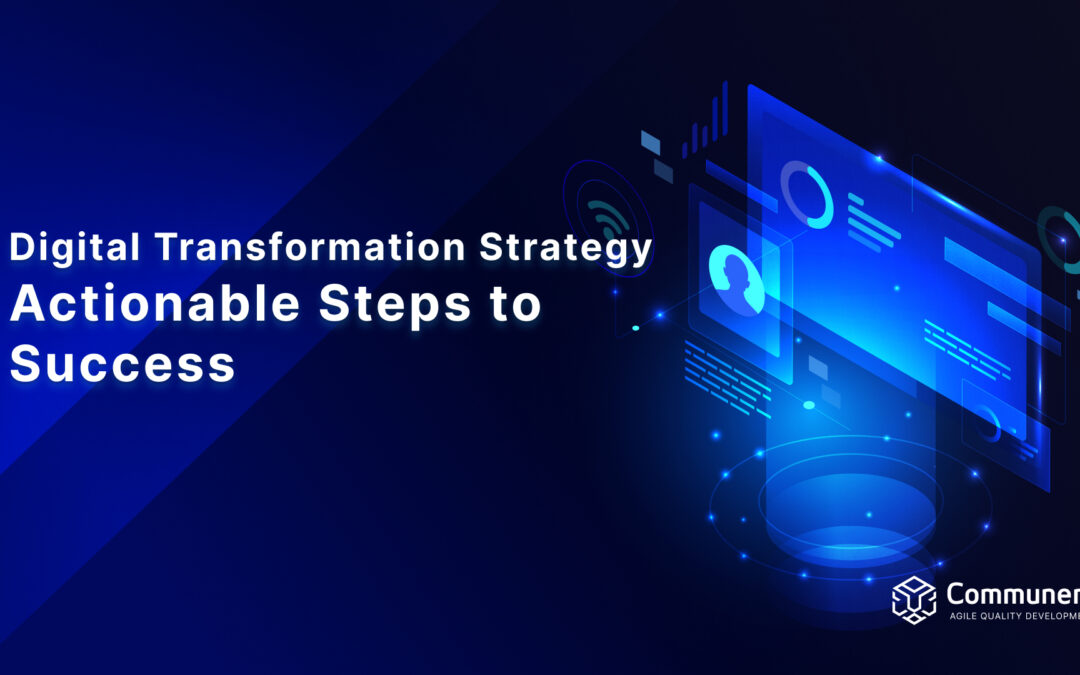Embracing digital transformation has become not just a strategic advantage but a necessity. It’s the process of leveraging digital technologies to fundamentally change the way businesses operate and deliver value to their customers. This paradigm shift encompasses various aspects of an organisation, from its processes and culture to customer interactions and business models.
Digital transformation isn’t merely about adopting new technologies; it’s about reimagining business operations and customer experiences. It involves integrating digital tools, data, and analytics into all facets of an organisation. This enables businesses to make data-driven decisions, enhance customer engagement, and ultimately drive growth and innovation.
In a study conducted by McKinsey, it was found that 80% of executives believe their business models are at risk if they don’t undertake a digital transformation journey. This highlights the critical nature of this shift in today’s highly competitive global market.
Table of Contents
- 9 Steps for Creating a Practical Digital Transformation Strategy
- 1. Assessing Your Current State
- 2. Setting Clear Objectives and Goals
- 3. Building a Cross-Functional Team
- 4. Selecting the Right Technologies
- 5. Developing a Data-Centric Approach
- 6. Managing Change and Adoption
- 7. Iterative Implementation and Testing
- 8. Monitoring and Measuring Progress
- 9. Ensuring Cybersecurity and Compliance
- Digital Transformation Strategy FAQs
- What are the key components of a successful digital transformation strategy?
- How can businesses overcome resistance to change during the transformation process?
- What role does data play in a digital transformation initiative?
- How do you measure the ROI of a digital transformation strategy?
- What are some common challenges businesses face when implementing digital transformation, and how can they be mitigated?
- Digital Transformation Strategy: The Conclusion
9 Steps for Creating a Practical Digital Transformation Strategy
A well-crafted digital transformation strategy acts as a roadmap, guiding an organisation through the complexities of change. It provides clarity of purpose, aligns resources, and ensures that all stakeholders are moving towards a common goal. Let’s delve into the nine actionable steps to crafting a successful digital transformation strategy.
1. Assessing Your Current State
Before embarking on a digital transformation journey, it’s crucial to understand where your organisation currently stands. This involves conducting a digital readiness assessment, identifying gaps and opportunities, and evaluating technological maturity. This assessment provides the foundation upon which you’ll build your strategy.
Conducting a Digital Readiness Assessment:
Begin by comprehensively evaluating your organisation’s existing digital capabilities. This includes an in-depth analysis of your current technologies, processes, and data management practices. Identify any outdated systems or processes that may hinder progress.
Identifying Gaps and Opportunities:
Pinpoint areas where your organisation falls short in terms of digital readiness. Are there bottlenecks in your workflows? Are there customer touchpoints that could be enhanced? Simultaneously, recognise opportunities where digital technologies can bring significant improvements or efficiencies.
Evaluating Technological Maturity:
Assess the maturity of your existing technologies. This involves examining factors like the compatibility of your systems, the level of automation in place, and the integration of data across different functions. Understanding your technological maturity is pivotal in determining what level of change is required.
If you find it hard to evaluate the current state of your business, consider getting help from a digital transformation consulting company. Such companies can do the initial heavy lifting for you.
2. Setting Clear Objectives and Goals
Aligning digital transformation with your business goals is paramount. These objectives should be specific, measurable, achievable, relevant, and time-bound (SMART). Defining key performance indicators (KPIs) ensures that progress can be tracked and realistic milestones keep the transformation on track.
Aligning Digital Transformation with Business Goals:
Ensure that your digital transformation objectives are tightly aligned with your broader business goals. For instance, if your goal is to increase customer retention, your digital initiatives might focus on enhancing the customer experience through personalised interactions and streamlined processes.
Defining Measurable Key Performance Indicators (KPIs):
Select KPIs that are directly tied to your digital transformation objectives. These could include metrics like customer acquisition costs, conversion rates, customer lifetime value, and operational efficiency gains. These quantifiable measures will serve as benchmarks for progress.
Establishing Realistic Milestones:
Break down your digital transformation journey into manageable milestones. Assign specific timelines and responsibilities for achieving each milestone. This incremental approach allows for a structured progression and provides clear markers of success along the way.
3. Building a Cross-Functional Team
Success in digital transformation relies heavily on the people driving it. Assemble a team with diverse skill sets and perspectives. Foster a culture of innovation that encourages creativity and problem-solving. Promote collaboration across departments to break down silos and ensure a holistic approach.
Assembling the Right Talent Pool:
Identify individuals within your organisation with the necessary skills and expertise to drive the digital transformation. Additionally, consider recruiting external talent with specialised knowledge in areas like data analytics, cybersecurity, and emerging technologies.
Fostering a Culture of Innovation:
Encourage a culture that embraces experimentation and innovation. Provide platforms for employees to share ideas and explore new technologies. Recognise and reward innovative thinking to reinforce the value placed on creativity.
Encouraging Collaboration Across Departments:
Break down silos by promoting cross-functional collaboration. Establish channels for open communication and knowledge-sharing between departments. This fosters a unified approach to digital transformation, where all teams work together towards common objectives.
4. Selecting the Right Technologies
Choosing the appropriate technology stack is a critical decision. Evaluate options carefully, paying attention to factors like customisation versus off-the-shelf solutions, scalability, and future-proofing. This ensures that the chosen technologies align with your long-term strategic vision.
Evaluating Technology Stack Options:
Thoroughly assess the available technology options, considering compatibility, scalability, and cost-effectiveness. Engage in vendor evaluations and consider consulting with experts to make informed decisions.
Customisation vs. Off-the-Shelf Solutions:
Determine whether off-the-shelf solutions meet your specific needs or if customisation is required. Off-the-shelf solutions offer speed of implementation, while customisation allows for a tailored approach to meet unique business requirements.
Scalability and Future-Proofing:
Select technologies that can scale with your business growth and are adaptable to emerging trends. Ensure that your chosen solutions have the capacity to evolve alongside the ever-changing digital landscape.
5. Developing a Data-Centric Approach
Data is the cornerstone of digital transformation. Leverage the power of data to gain valuable insights into customer behaviour, market trends, and operational efficiencies. Implement robust data governance and privacy measures to safeguard sensitive information.
The Power of Data:
Establish mechanisms to collect, store, and analyse data effectively. This includes investing in robust data management platforms and establishing data pipelines to ensure a steady flow of information.
Implementing Data Governance and Privacy Measures:
Adopt stringent data governance practices to maintain data integrity and compliance. This involves setting policies for data access, security, and privacy. Ensure that your practices align with industry regulations and standards.
Leveraging Advanced Analytics for Insights:
Employ advanced analytics techniques, such as machine learning and predictive modelling, to derive actionable insights from your data. These insights can inform strategic decisions, drive personalisation efforts, and uncover new business opportunities.
6. Managing Change and Adoption
Resistance to change is a common hurdle in any transformation process. Employ change management best practices to navigate this challenge. Provide thorough employee training and upskilling to equip your workforce with the necessary skills. Effective communication of the vision and benefits is crucial in gaining buy-in.
Change Management Best Practices:
Implement a structured change management framework to guide employees through the transformation process. This includes clear communication of the reasons for change, providing training and support, and addressing concerns in a timely manner.
Employee Training and Upskilling:
Invest in comprehensive training programs to equip employees with the skills needed for the digital landscape. This may involve workshops, online courses, or partnering with external training providers. Continual upskilling ensures that your workforce remains proficient in the latest technologies.
Communicating the Vision and Benefits:
Consistent and transparent communication is key. Clearly articulate the vision for digital transformation and the benefits it brings to the organisation, employees, and customers. Use various channels, such as town hall meetings, newsletters, and workshops, to ensure the message reaches all stakeholders.
7. Iterative Implementation and Testing
Rather than a one-size-fits-all approach, opt for a phased rollout strategy. Implement changes iteratively, allowing for continuous testing and feedback loops. This agile approach enables adjustments to be made based on real-world results, enhancing the chances of success.
Phased Rollout Strategy:
Adopt an incremental approach to implementation. Start with a smaller-scale pilot project to test the waters before scaling up. This allows for early identification of challenges and the opportunity to make necessary adjustments before full-scale deployment.
Continuous Testing and Feedback Loops:
Establish rigorous testing protocols to evaluate the performance and functionality of new technologies and processes. Gather feedback from end-users, both internal and external, to identify areas for improvement and refinement.
Agility and Adaptability in Implementation:
Embrace an agile methodology, allowing for flexibility and quick adjustments as needed. This nimble approach enables your organisation to respond effectively to changing market dynamics and evolving customer needs.
8. Monitoring and Measuring Progress
Establish clear performance metrics to track the impact of the transformation. Regularly monitor KPIs and be prepared to adjust strategies as needed. Address challenges promptly and be adaptable in the face of unforeseen circumstances.
Implementing Performance Metrics:
Define a comprehensive set of performance metrics that align with your digital transformation objectives. These may include financial metrics, customer satisfaction scores, time-to-market, and operational efficiency indicators.
Tracking KPIs and Adjusting Strategies:
Regularly monitor KPIs and compare them against established benchmarks. Use these insights to make data-driven adjustments to your digital transformation strategy. This iterative process ensures that your efforts remain on course and continue to deliver value.
Addressing Challenges and Course-Correcting:
Be proactive in identifying and addressing challenges that may arise. Whether it’s a technological hurdle or a shift in market dynamics, having a mechanism in place to course-correct ensures that your digital transformation remains resilient in the face of adversity.
9. Ensuring Cybersecurity and Compliance
As digital operations expand, so do cybersecurity threats. Building a robust security infrastructure is essential. Additionally, compliance with data protection regulations is non-negotiable. Proactive threat monitoring and response mechanisms are crucial in safeguarding your digital assets.
Building a Robust Security Infrastructure:
Invest in state-of-the-art cybersecurity measures to protect your digital assets. This includes firewalls, encryption protocols, regular security audits, and employee awareness training on cybersecurity best practices.
Compliance with Data Protection Regulations:
Stay abreast of data protection regulations such as GDPR, HIPAA, or industry-specific standards. Implement processes and technologies to ensure compliance and safeguard sensitive customer information.
Proactive Threat Monitoring and Response:
Establish a dedicated cybersecurity team or partner with a trusted provider to monitor for potential threats. Implement real-time threat detection systems and have a well-defined incident response plan.
Digital Transformation Strategy FAQs
What are the key components of a successful digital transformation strategy?
A successful digital transformation strategy encompasses a thorough assessment of the current state, clear objectives, a cross-functional team, appropriate technologies, a data-centric approach, change management practices, iterative implementation, progress monitoring, and robust cybersecurity and compliance measures.
How can businesses overcome resistance to change during the transformation process?
Overcoming resistance to change requires effective change management practices, comprehensive employee training and upskilling, and transparent communication of the benefits and vision of the transformation.
What role does data play in a digital transformation initiative?
Data is the bedrock of digital transformation. It provides valuable insights for informed decision-making, enhances customer experiences, and drives operational efficiencies. Implementing data governance and privacy measures ensures the responsible use of this invaluable resource.
How do you measure the ROI of a digital transformation strategy?
Measuring the ROI of a digital transformation strategy involves tracking key performance indicators (KPIs) related to business objectives. These could include metrics like revenue growth, cost savings, customer satisfaction scores, and employee productivity improvements.
What are some common challenges businesses face when implementing digital transformation, and how can they be mitigated?
Common challenges include resistance to change, inadequate skill sets, technology integration issues, and cybersecurity concerns. These can be mitigated through effective change management, comprehensive training and upskilling, careful technology selection, and robust cybersecurity measures.
Digital Transformation Strategy: The Conclusion
Embarking on a digital transformation journey is a formidable undertaking, but one that holds the potential to level up your business. By following these meticulously detailed steps, you’re not only laying the foundation for a successful digital transformation but also positioning your organisation for sustained growth and innovation.
Remember, digital transformation is not a one-time event but an ongoing journey towards a future-ready, customer-centric, and agile business model. Celebrate each milestone, no matter how small, and continue to champion a culture of innovation and adaptation. This commitment to progress will be the driving force behind your organisation’s success in the digital age.




![Why Custom Web Development is the Best Approach [2024]](https://resources.communere.com/wp-content/uploads/2024/02/Why-Custom-Web-Development-is-the-Best-Approach-1024x570.jpg)

